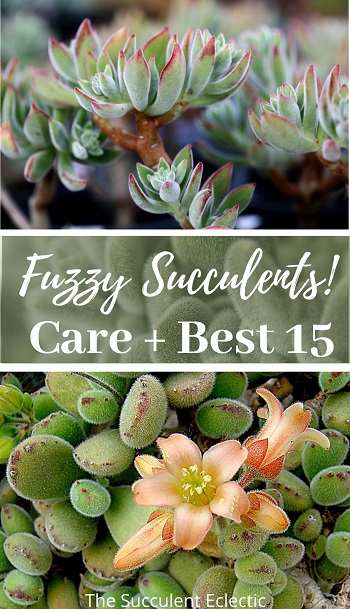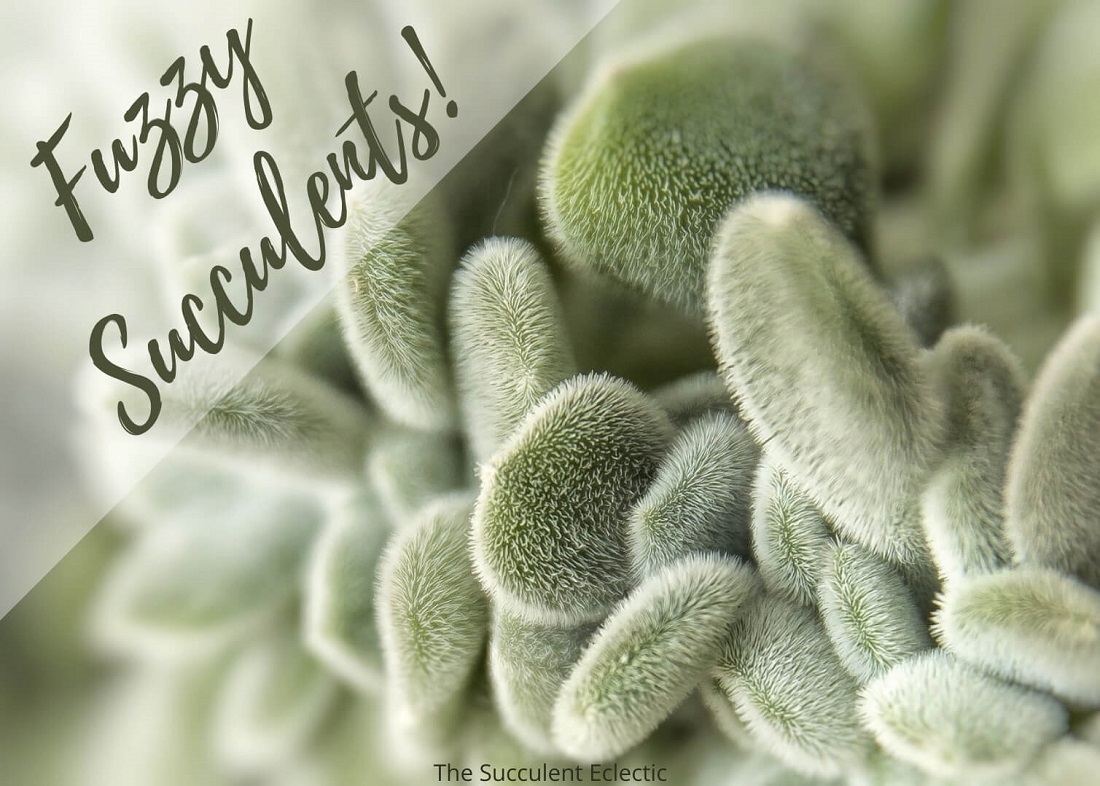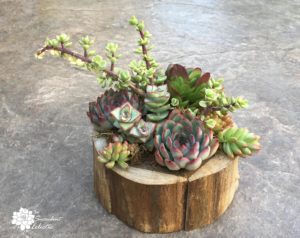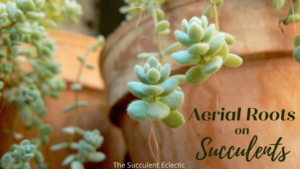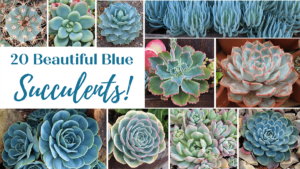One of the (many) facets of succulents that makes them so appealing is their incredible diversity — of form, color, size and texture. All succulents have adapted to their native environment by storing water in their leaves, stems and roots for future use. That’s what makes them “succulent”. But some succulents have developed additional, unusual adaptations that make them particularly intriguing. Today, let’s take a look at fuzzy succulents. These plants have tiny hairs all along their leaf surfaces, giving them a soft, pettable look and feel. These furry succulents seem to almost blur the line between plants and animals. The fuzziness serves important functions beyond charming the grower.
All About Fuzzy Succulents & Their Care
In this Post We'll Cover:
- All About Fuzzy Succulents & Their Care
- Why Some Succulents Have Fuzzy Leaves
- Care for Fuzzy Succulents
- Top 15 Fuzzy Succulents
- Kalanchoe tomentosa
- Echeveria setosa
- Sedum dasyphyllum
- Senecio haworthii – Cocoon Plant
- Sempervivum ‘Fuzzy Wuzzy’
- Cotyledon tomentosa “Bear Paws”
- Echeveria pulvinata – “Chenille Plant”
- Kalanchoe orgyalis ‘Copper Spoons’
- Crassula congesta
- Cyanotis somaliensis — Pussy Ears
- Delosperma echinatum – Pickle Plant
- Echeveria Doris Taylor
- Plectranthus tomentosa – Vicks Plant
- Kalanchoe beharensis ‘Fang’
- Crassula mesembryanthemoides
{Please note, some links in this post may be affiliate links to sites that pay me a small commission if you click on the link and make a purchase. This commission is at absolutely no cost to you. I only recommend products and companies that I have worked with and truly love! ~Kat}
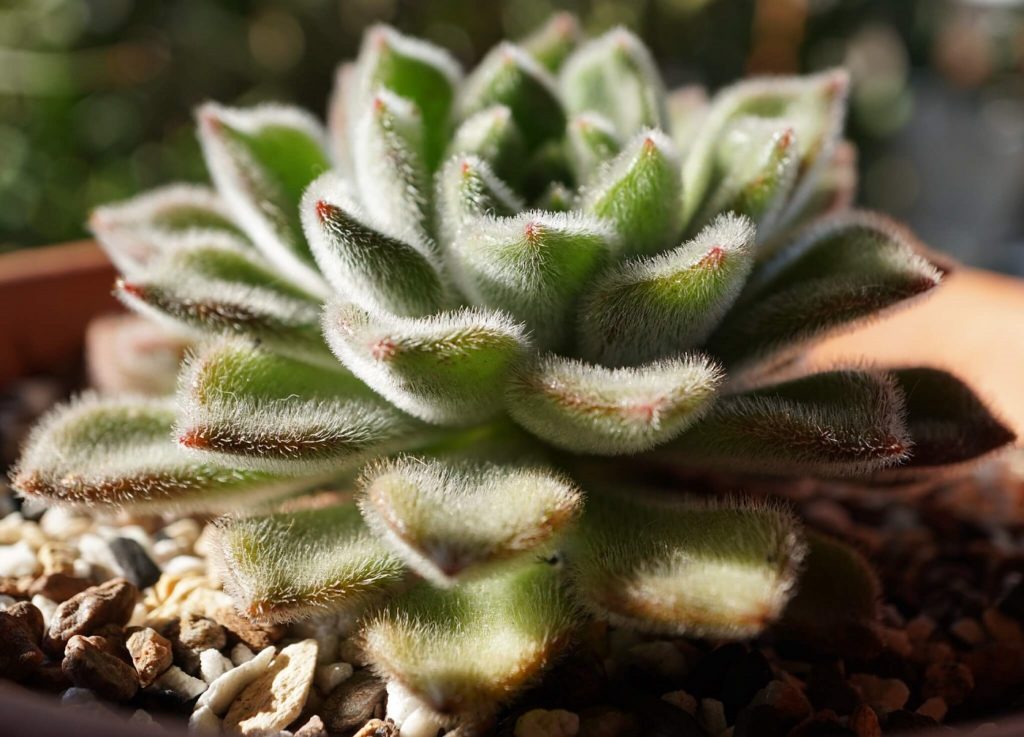
A number of succulent genera include fuzzy succulents, often with common names that liken them to animals. Silver panda, teddy bear, bear paws and kitten ears are on my list. If you’re collecting a “petting garden”, you’ll find some excellent examples among Kalanchoe, Echeveria, Sempervivum, Seum, Senecio, Crassula, Delosperma and more. In addition to the reasons behind the evolution of furry succulents and how to care for them, I’ll share with you my top 15 favorites. There is a lot to cover here. Feel free to skip ahead!
- Why Some Succulents Have Fuzzy Leaves
- Care for Fuzzy Succulents
- Top 15 Fuzzy Succulents
- Kalanchoe tomentosa
- Echeveria setosa
- Sedum dasyphyllum
- Senecio haworthii – Cocoon Plant
- Sempervivum ‘Fuzzy Wuzzy’
- Cotyledon tomentosa “Bear Paws”
- Echeveria pulvinata – “Chenille Plant”
- Kalanchoe orgyalis ‘Copper Spoons’
- Crassula congesta
- Cyanotis somaliensis — Pussy Ears
- Delosperma echinatum — Pickle Plant
- Echeveria Doris Taylor
- Plectranthus tomentosa – Vicks Plant
- Kalanchoe beharensis ‘Fang’
- Crassula mesembryanthemoides
Why Some Succulents Have Fuzzy Leaves
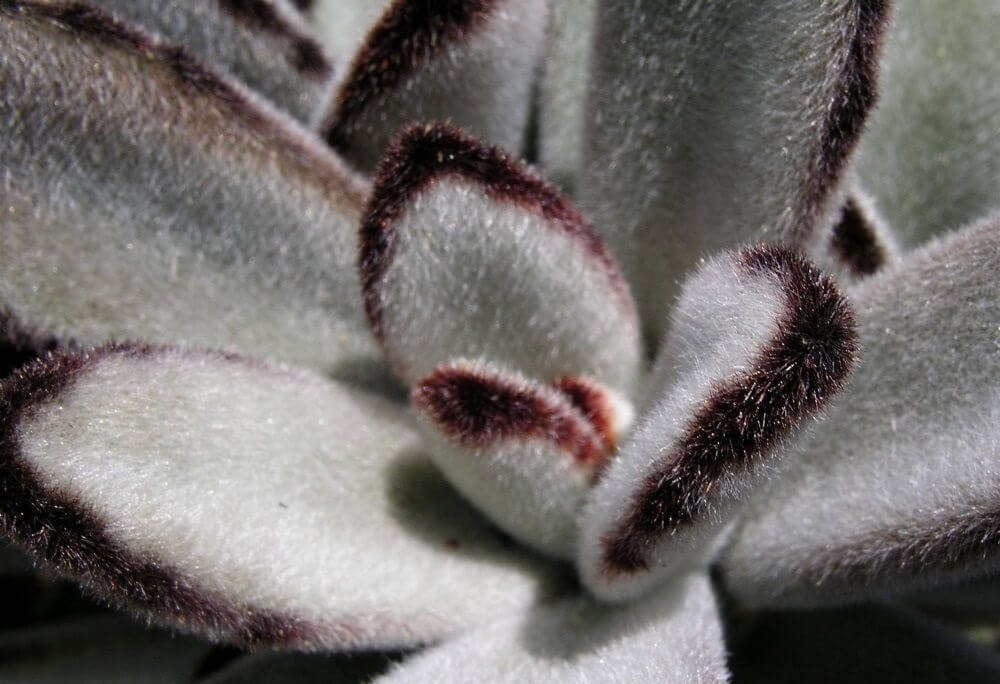
The vast majority of succulents are native to hot, dry climates with few trees for shade. It is a challenge to thrive in the intense light in these habitats. Some succulents like Haworthia, Lithops and Fenestraria develop leaf windowsLeaf windows are specialized leaf structures specific to som... More, so the main plant can grow underground. Many succulents develop colorful pigments to protect them from sunburn. This is a common cause of succulents changing color. Some varieties develop a protective sunscreen known as farina or epicuticular wax to protect them from the intense sun. Fuzzy succulents develop furry leaves for the same reason — to protect the plant from burning or drying out in bright, hot conditions.
Fuzzy succulents form slender “hairs” called trichomes on their leaves. The development ranges from a very short, velvety covering through furry leaves to long, pronounced hairs. No matter the form, each variety of fuzzy succulent gains a variety of protections from their “fur”.
Each tiny hair casts a tiny bit of shade on the leaf, protecting it from overheating and water loss. As small as the amount of shade is, multiply it by hundreds or thousands upon every leaf and it adds up to significant protection. The hairs also disrupt the airflow against the leaf, reducing the loss of moisture from the leaves to a drying wind. Fuzzy succulent leaves also protect their precious stores of water from thirsting herbivores and insects. Deer and rabbits don’t like to feed on furry foliage.
Care for Fuzzy Succulents
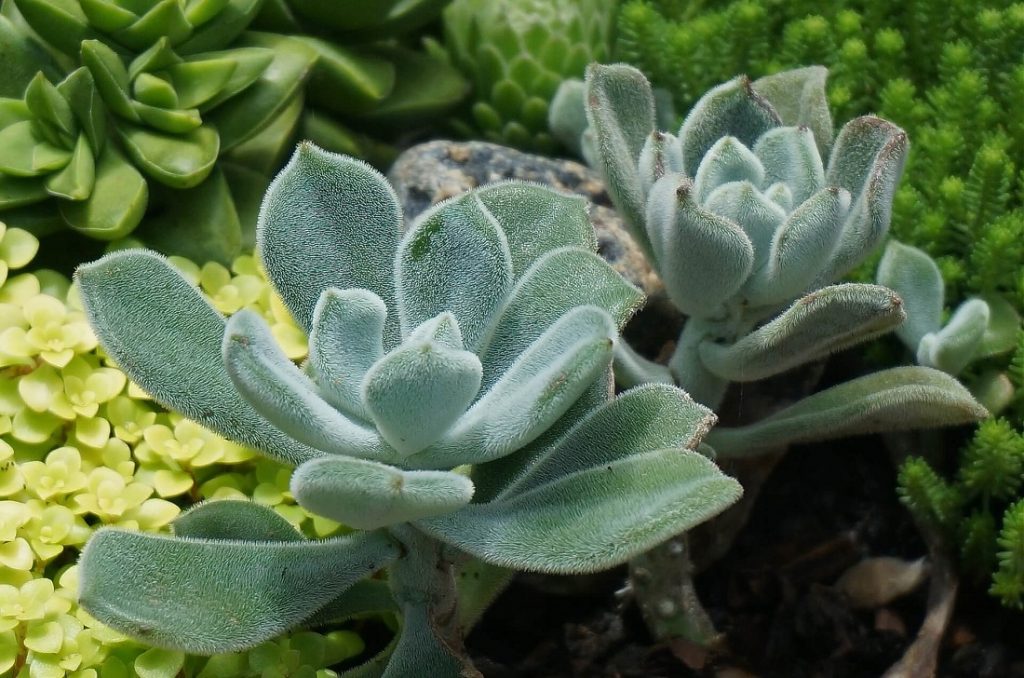
Fuzzy succulents include a range of cactus with fuzz, fur or long hair. While fuzzy succulent leaves are safe to touch, hands off the furry-looking cactus! Most have vigorous spines within the hair. But furry succulents are quite safe to touch or even pet. Since it can be difficult to judge the color of the leaf under the fuzz, using touch to evaluate the health of these succulents is even more important than with smooth succulents.
In general, fuzzy succulent care is just like that for smooth-skin succulents. Be sure to follow the following guidelines:
- Always plant in fast-draining succulent soil.
- Choose a container with good drainage.
- Water thoroughly, but only when the succulent soil is dry.
- Provide as much bright light as the succulent can take.
Although fuzzy leaves protect the succulent from the sun, still take care not to expose your plant to too much sun, or it will sunburn. And the best practice for watering fuzzy succulents is to apply water at the soil line, rather than from overhead. Avoid getting the furry succulent leaves wet. It can lead to rot.
Amazon tools and soil
Top 15 Fuzzy Succulents
Now, for the fun part! These are my top 15 fuzzy succulents. Some may be old favorites, but I’m confident you’ll meet several new ones.
Kalanchoe tomentosa
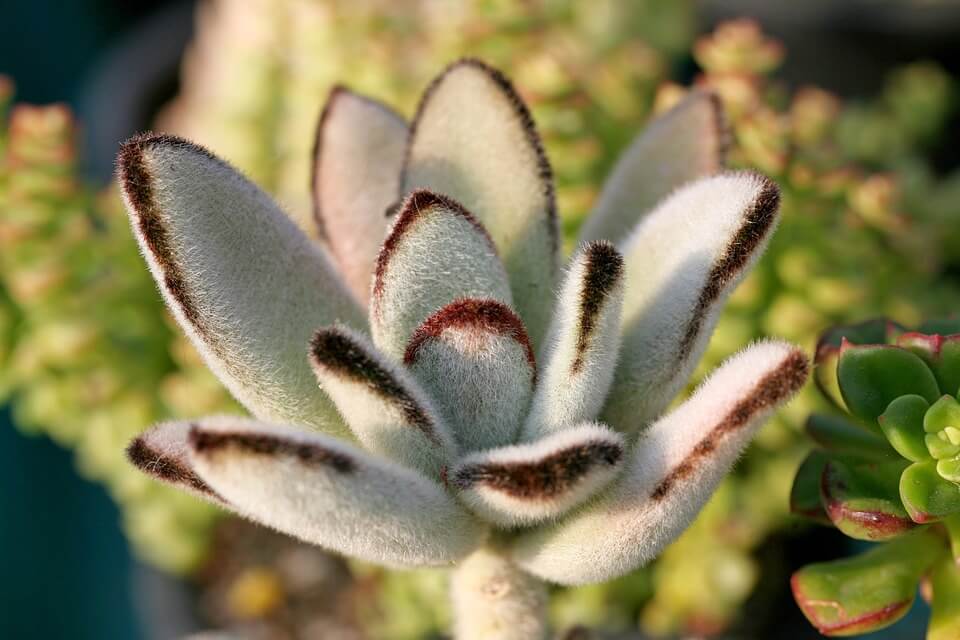
Likely most people’s favorite fuzzy succulent, Kalanchoe tomentosa ‘Silver Panda’ has a number of upright leaves, shaped like bunny ears, covered in soft, silvery “fur”. The leaf margins have dark chocolate markings, making for a lovely contrast. ‘Silver Panda’ has a number of furry cousins, Kalanchoe tomentosa all. Kalanchoe tomentosa ‘Chocolate Soldier’ is green and tan to brown in color. ‘Cinnamon’, as the name suggests is more of a reddish brown color. ‘Black Tie” is a lighter and brighter version of Silver Panda, with blacker markings at the margins. Kalanchoe tomentosa “Teddy Bear’ is as adorable as it sounds, with shorter, rounder, fuzzy tan leaves forming loose rosettes, with cinnamon to chocolate markings on the leaf margins. All Kalanchoe tomentosa can be propagated by stem cuttings or individual leaves.
All varieties of Kalanchoe tomentosa thrive in partial sun to bright, indirect light. All are hardy just to zone 10, (30° F, -1° C), so protect them from freezing by bringing them indoors over the winter. They can be happy indoors year-round with plentiful light.
Echeveria setosa
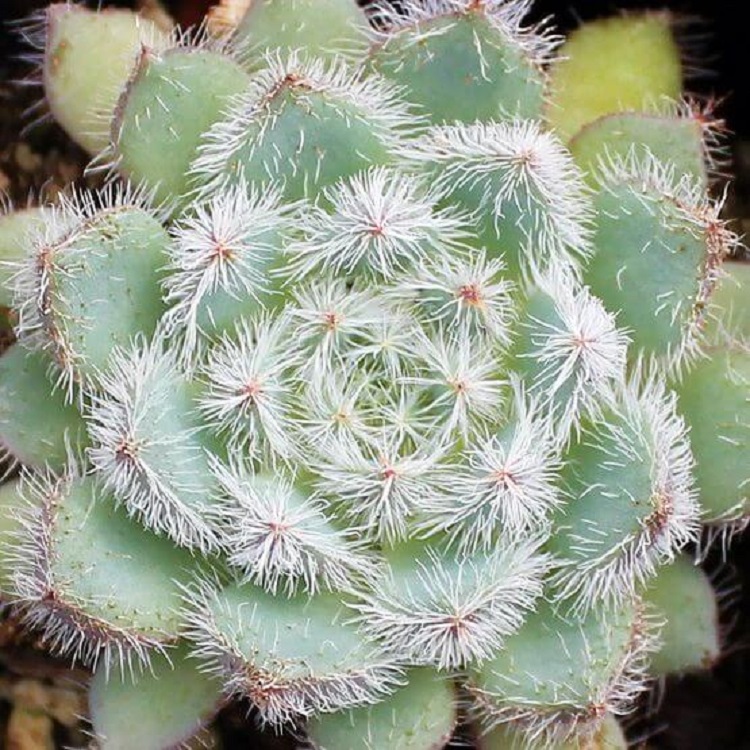
Echeveria setosa is a charmer with prominent hairs giving it a furry appeal. These hairs on this fuzzy succulent also serve to capture dew from the air, enabling the plant to eek out every trace of moisture in its environment. The rosettes remain small, reaching just 4 inches wide and 3 inches tall. The soft, flexible hairs make an intriguing texture when you include setosa in mixed succulent plantings. Don’t let the hairy leaves through you off, E. setosa can be propagated by leaves just like any Echeveria.
Echeveria setosa thrives in partial sun to filtered shade. It is hardy just to zone 10, (30° F, -1° C), so protect it over the winter.
Sedum dasyphyllum
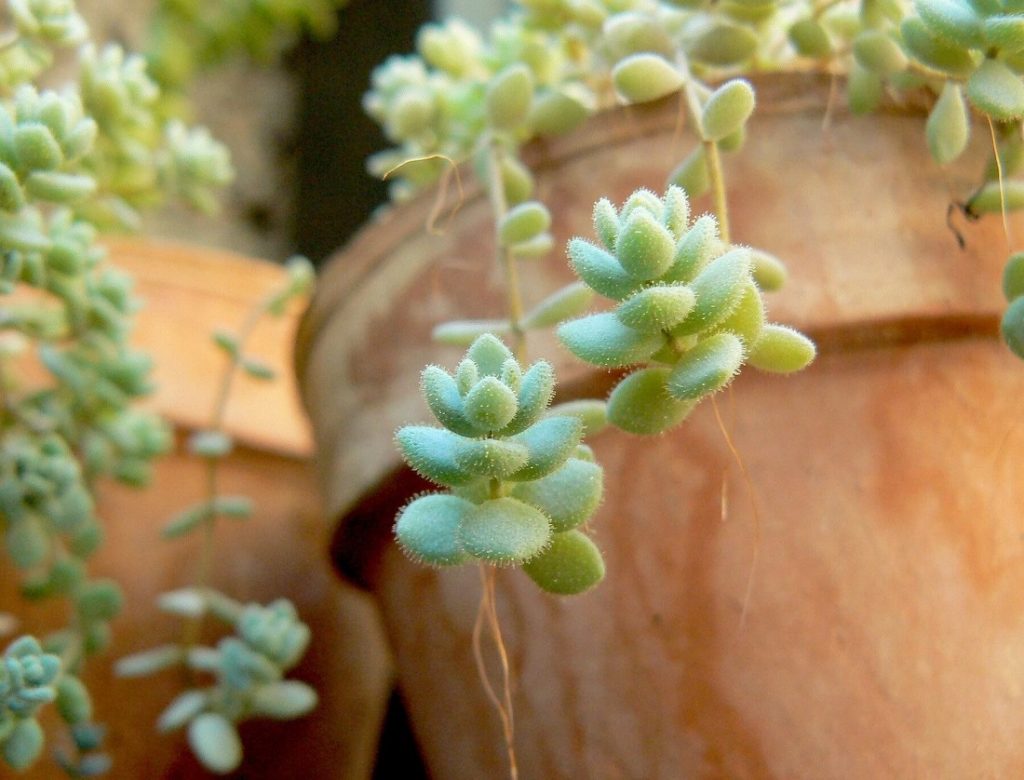
Sedum dasyphyllum ‘Fuzzy Wuzzy’ forms chubby little rosettes covered with tiny, fine hairs. (BTW, I loved the Fuzzy wuzzy was a bear when I was a child!) This furry succulent forms dense mats that will spill over the edge of a container to make for a charming, trailing plant. It grows just 3-4 inches tall and is an attractive hanging succulent. I’ve seen a single rosette used as a “shrub” in a fairy garden to wonderful effect! Sedum dasyphyllum can be successfully propagated by division, stem cuttings and leaves.
Sedum dasyphyllum thrives in full sun and is hardy to zone 8B, (15° F, -9°C). Cold hardy in moderate climates, provide protection in a truly cold winter.
Senecio haworthii – Cocoon Plant
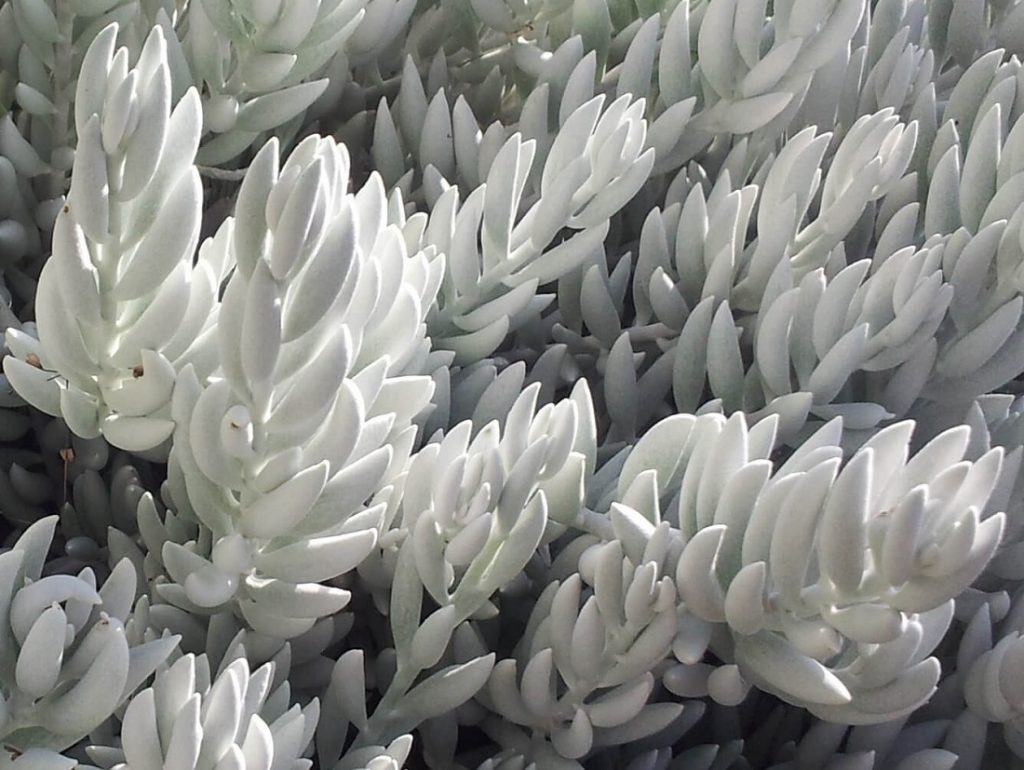
Senecio haworthii (syn Caputia tomentosa) is commonly known as the cocoon plant or woolly Senecio. The white, fuzzy succulent leaves look just like a cluster of cocoons, awaiting the reveal of so many butterflies. This plant forms a small shrub, with multiple, woody and branched stems, reaching 9-12 inches tall. The color is striking and cooling in the garden or in mixed arrangements. Grow your collection of cocoon plant by stem cuttings or propagatingPropagating (PRAH-puh-gate-ing) a plant is to grow another p... individual leaves.
Senecio haworthii grows well in full sun to bright light indoors and is hardy just to 10, (30° F, -1° C). Protect it from freezing, bringing it indoors over the winter.
Sempervivum ‘Fuzzy Wuzzy’
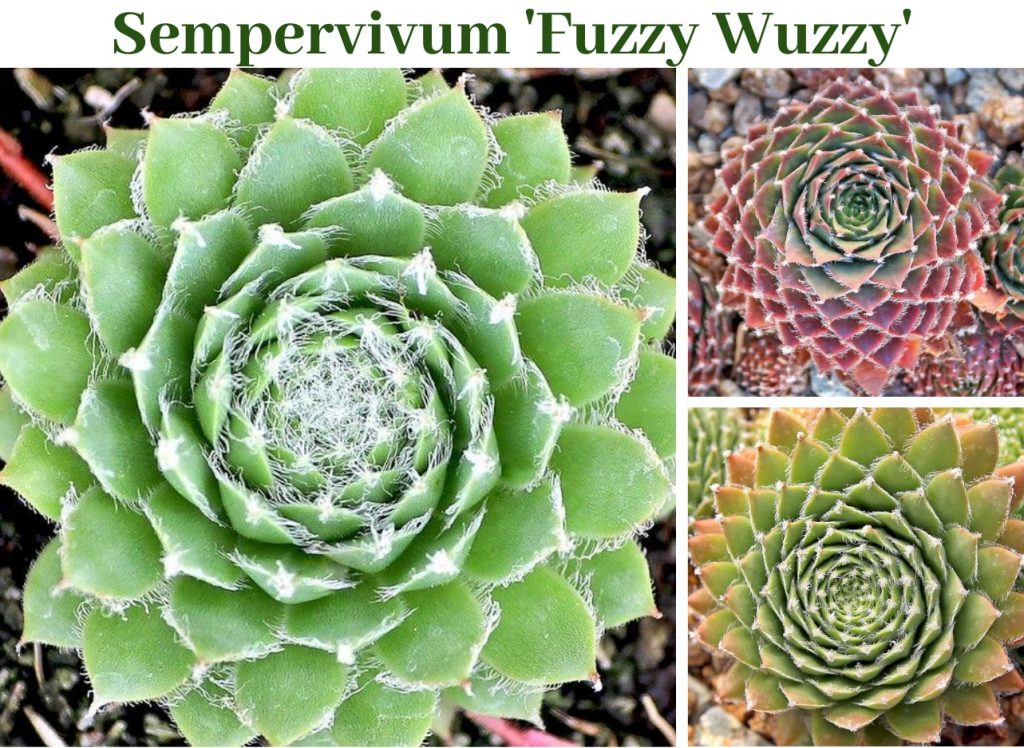
Remember the child’s rhyme Fuzzy Wuzzy was a bear? I absolutely loved that as a child, and Sempervivum Fuzzy Wuzzy has captured my heart! The leaf margins have a riot of trichomes that lend a fuzzy appeal. The green rosettes blush rose and golden throughout the year. Strangely, this sempervivum is highly prone to cresting, creating fabulous curls and forms. Also known as hens and chicks, this fuzzy succulent remains under 3 inches tall and makes an excellent succulent groundcover. Propagate Fuzzy Wuzzy by dividing the “chicks” from the “hens”.
Sempervivum Fuzzy Wuzzy performs best in full to partial sun. Its hardy to zone 5, (-15°F / -26° C). This is an excellent selection for cold winter climates.
Cotyledon tomentosa “Bear Paws”
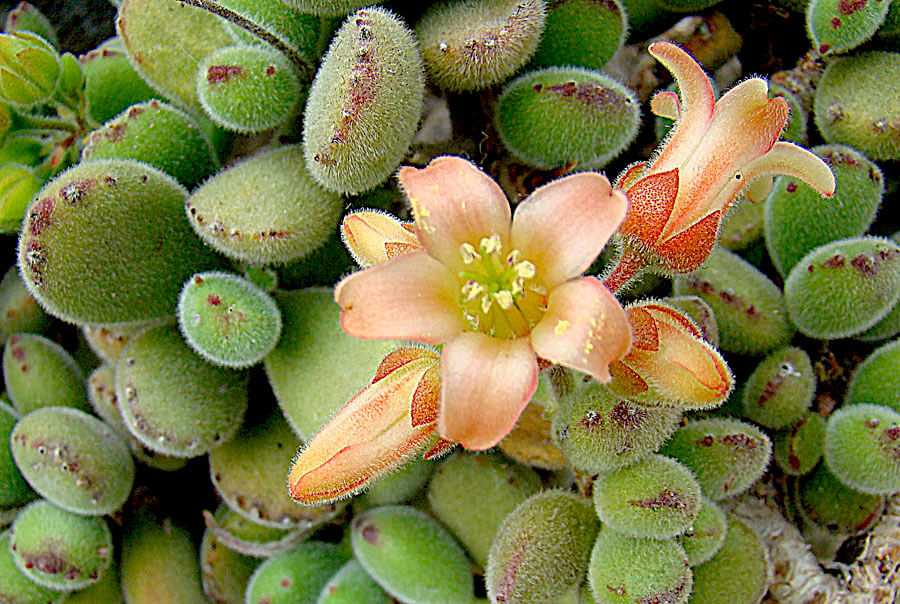
Cotyledon tomentosa is an adorable, fuzzy succulent whose leaves look like the paws of a bear. See the little toes/claws? The round, pudgy leaves come to a series of small pink to brown points. Like the first item in our list, this has “tomentosa” in the name — the word means “covered in hairs”. You won’t be able to resist petting these paws! Be gentle, the leaves pop off fairly easily, a sure signal they propagate well by leaf as well as stem cuttings. The plant grows 6-8″ tall and is such a charmer!
Cotyledon Bear Paws grows well in bright indoor light or filtered light outdoors. Its hardy just to zone 10, (30° F, -1° C), so be sure to protect it from freezing come winter.
Echeveria pulvinata – “Chenille Plant”
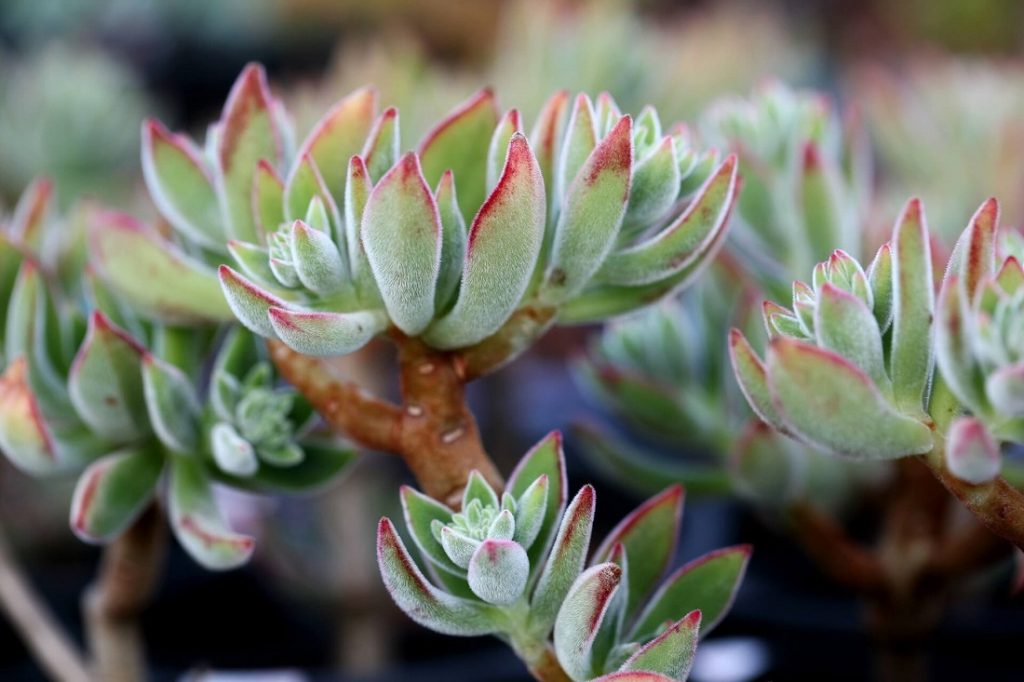
The lovely Echeveria pulvinata ‘Ruby’ forms rosettes of green leaves with vivid red margins. Covered by short, velvety trichomes, it has a silvered look. Unlike most Echeveria, pulvinata tends to develop woody branches, rising to a heigh of 9-12 inches. Propagate the “chenille plant” using stem cuttings and individual leaves.
Echeveria pulvinata thrives in full sun to partial sun. Hardy to zone 10, 30° F, -1° C) E. pulvinata needs to be protected from freezing.
Kalanchoe orgyalis ‘Copper Spoons’
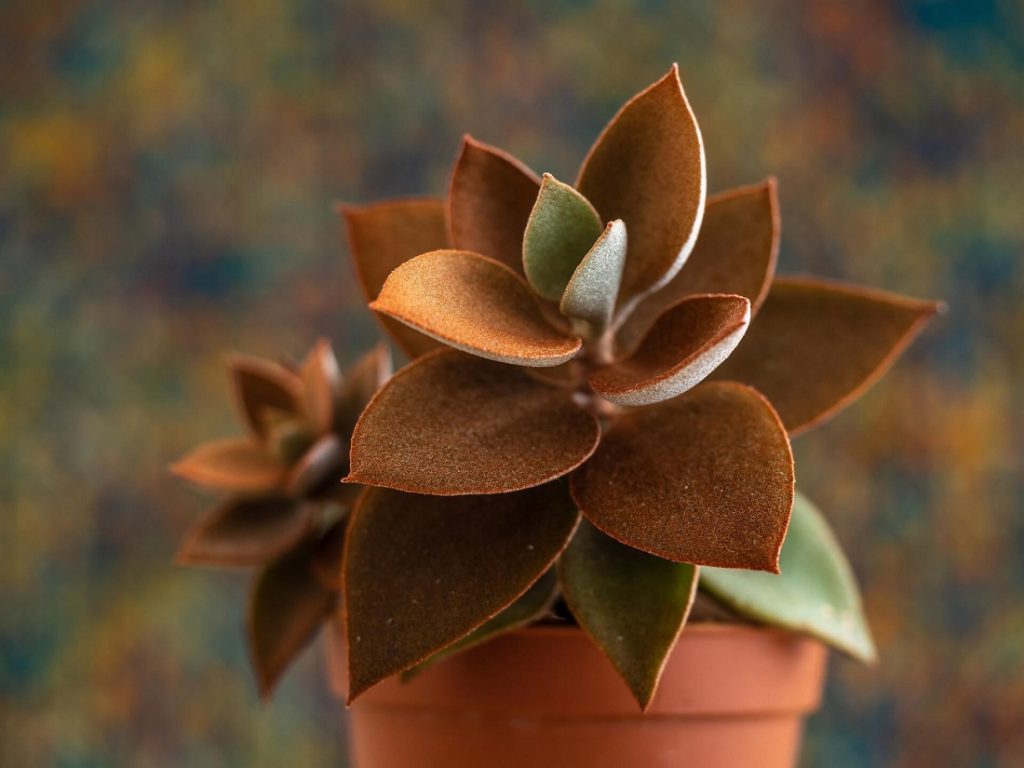
Kalanchoe orgyalis ‘Copper Spoons’ is a striking variety with velvety leaves that are a rich, cinnamon on the top and silvery-white underneath. This handsome, fuzzy succulent grows 12 inches or more in height. Copper Spoons adds wonderful color and texture to mixed succulent arrangements. Propagate Copper Spoons using stem cuttings or individual leaves.
For best performance, provide Copper Spoons with partial sun to bright, filtered light. Hardy just to zone 10, (30° F, -1° C), Kalanchoe orgyalis must be protected from freezing come winter.
Crassula congesta
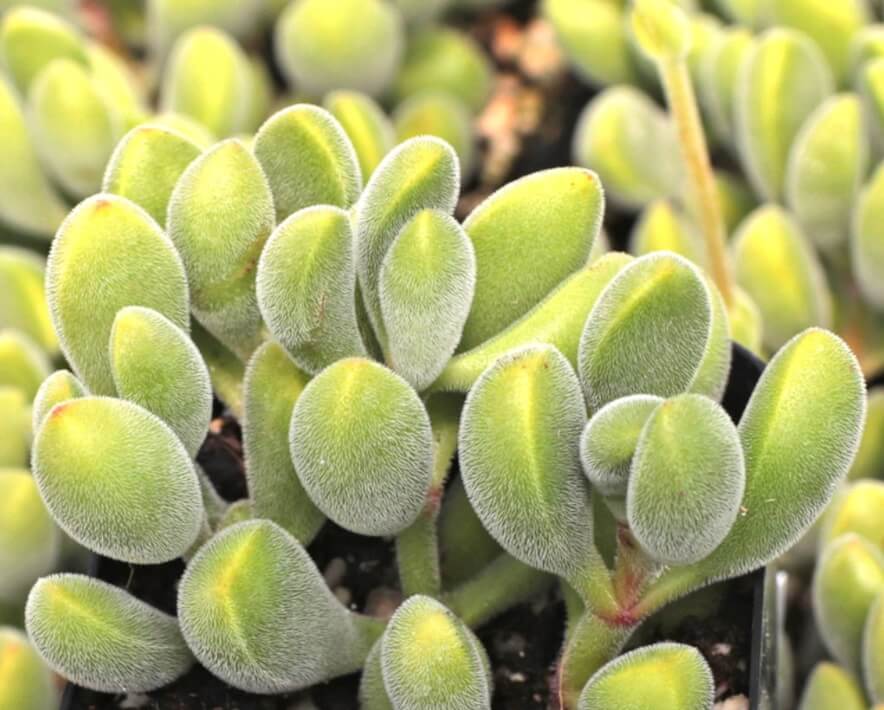
Another favorite for mixed succulent arrangements is Crassula congesta. Stems reach 6-8 inches tall, with clusters of pudgy leaves, round on one side and flat on the other. The fine, fuzzy hairs give congesta’s green leaves a “frosted” appearance. Easily propagated by individual leaves and stem cuttings, this will fast become a favorite in your collection.
Crassula congesta grows best in partial or filtered sun or bright light indoors. Bring it indoors for the winter. It is hardy just to zone 10, (30° F, -1° C).
Cyanotis somaliensis — Pussy Ears
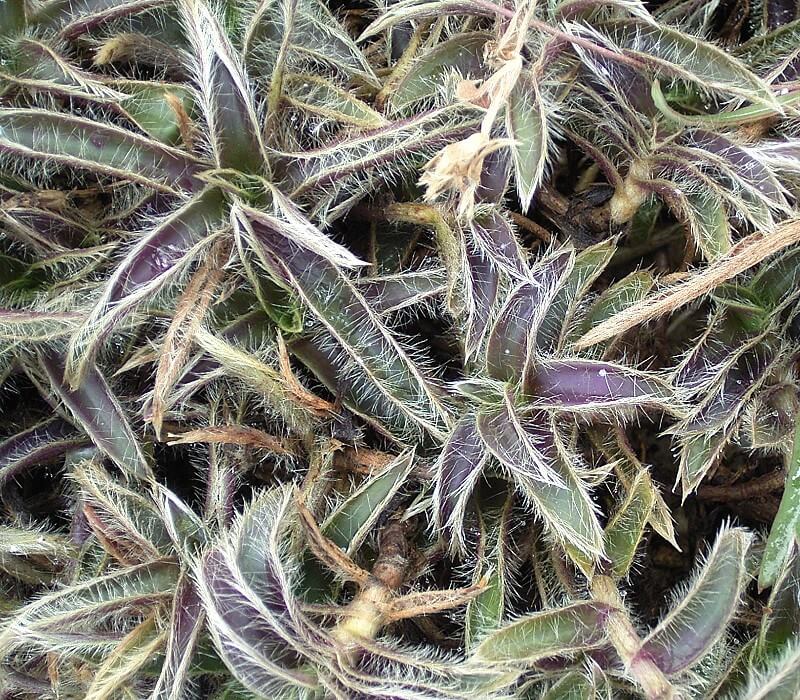
Cyanotis somaliensis is an unusual and furry succulent that goes by the common names of “pussy ears”, “kitten ears” and “furry kittens”. It grows 12-18 inches tall and produces trailing stems. and looks wonderful growing in a hanging basket. Closely related to Tradescantia, kitten ears form showy violet flowers. Stem cuttings are the best way to propagate this fuzzy succulent.
Provide Cyanotis somaliensis with filtered sun or bright indoor light. It is hardy just to zone 10, (30° F, -1° C), soo it should overwinter indoors in most climates.
CHANGING Colorful succs for MCG
Delosperma echinatum – Pickle Plant
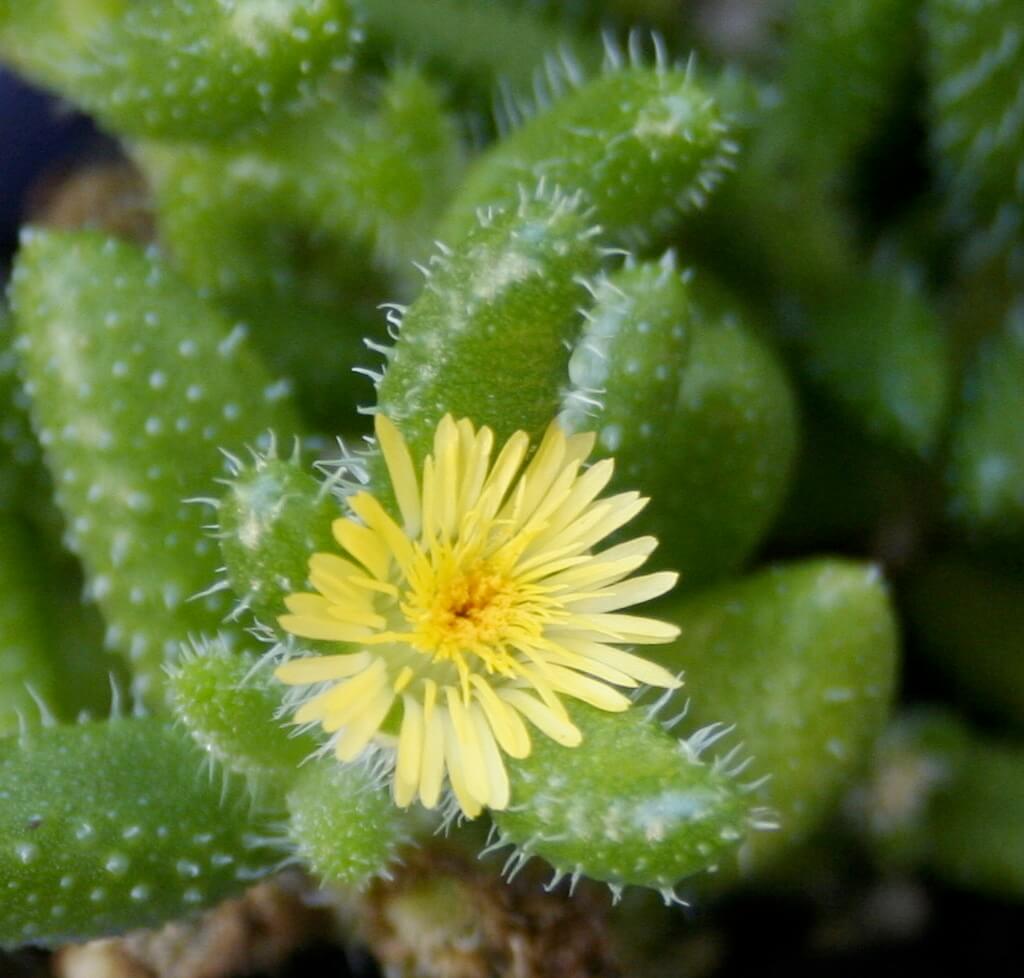
Delosperma echinatum forms spiny-looking little hairs across the pudgy, green leaves, giving it a prickly appearance and an intriguing texture. Commonly known as the pickle plant, this is an easy-to-grow succulent native to rocky habitats in South Africa. The pickle plant grows 6-8 inches tall and is ideal for rock gardens and tumbling over the edge of a container. Propagate by stem cuttings or using individual leaves.
Delosperma echinatum thrives in partial sun to filtered light or bright light indoors. Hardy just to zone 10, (30° F, -1° C), the pickle plant should be brought indoors for the winter.
Echeveria Doris Taylor
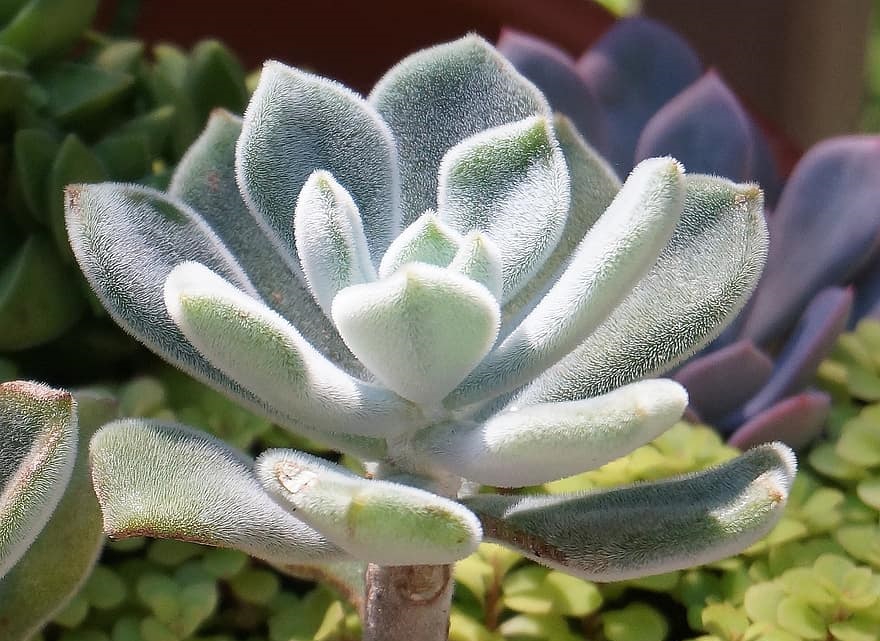
Echeveria Doris Taylor is among the most elegant of all fuzzy succulents. The short, soft trichomes give the appearance of silvered frost to the rosettes and leading to its common name of “woolly rose”. It is a hybrid of Echeveria setosa and pulvinata, listed above and forms multiple offsetsSucculent offsets are the baby succulents that form at the b... readily, growing into extended clumps. Sizeable rosettes reach 3-5″ tall and up to 8 inches wide. As with most Echeveria, Dorish Taylor propagates beautifully by individual leaves.
Echeveria Doris Taylor thrives in partial to filtered sun. It’s hardy just to zone 10, (30° F, -1° C), so be sure to protect it from freezing over the winter.
Plectranthus tomentosa – Vicks Plant
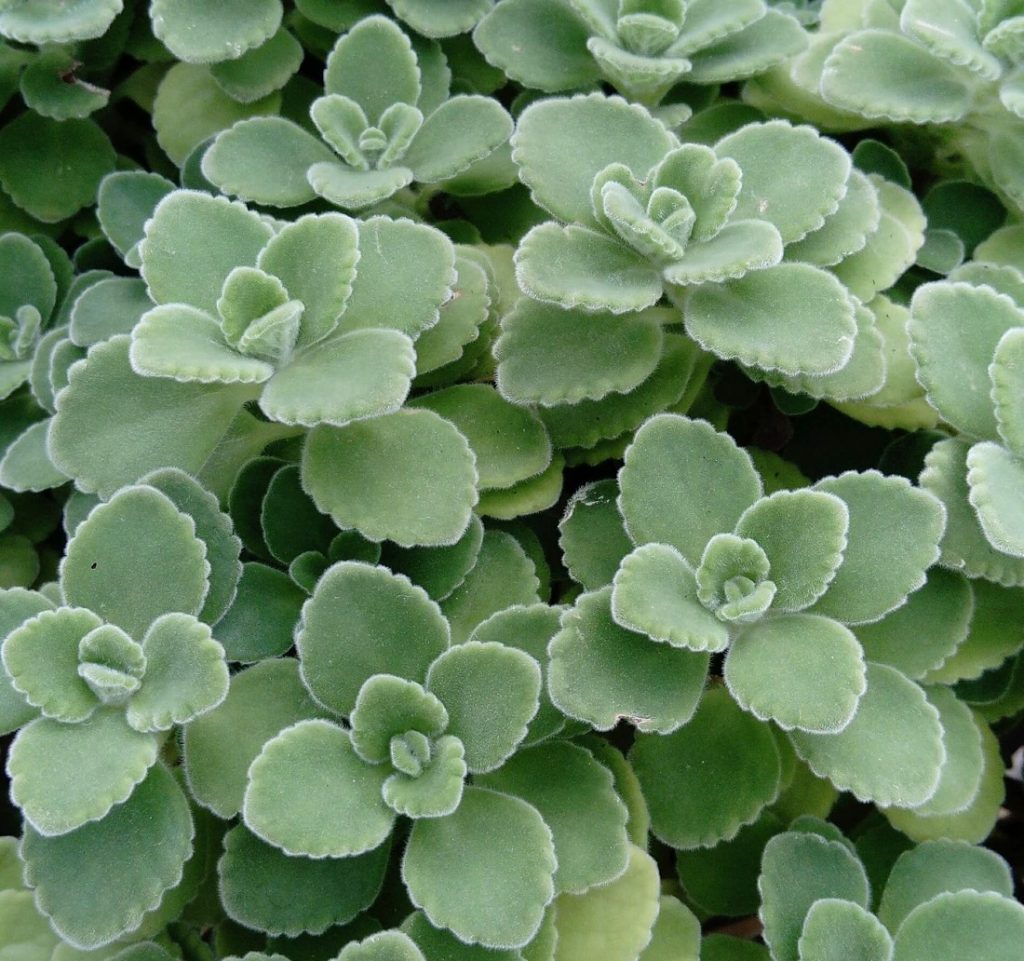
Plectranthus tomentosa is a fuzzy succulent sometimes called a “succulent coleus” or “Cuban oregano”. It is a member of the mint family, with velvety leaves that have a minty scent like camphor, leading to the common name Vicks plant. Scalloped, green leaves get a silvery sheen from the fine fuzz of trichomes. The Vicks plant grows 12 inches tall or taller and produces masses of showy lavender blooms. Propagate using individual leaves or stem cuttings.
Plectranthus tomentosa thrives in full sun. Protect it from freezing by bringing it indoors over the winter. It is hardy just to zone 10, (30° F, -1° C).
Kalanchoe beharensis ‘Fang’
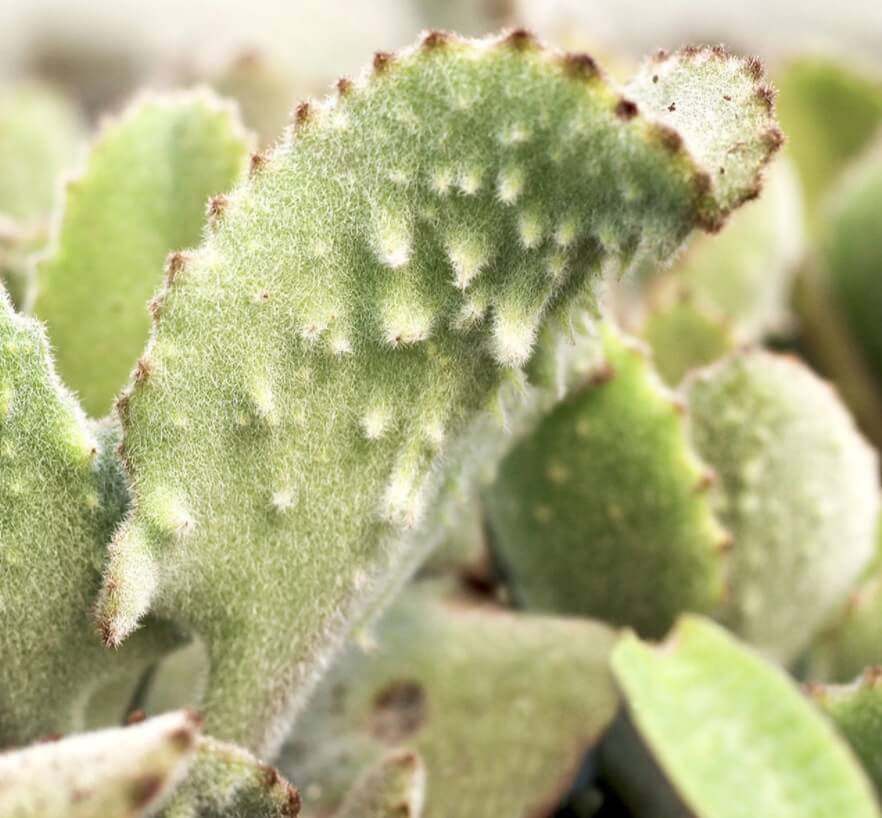
Kalanchoe beharensis ‘Fang’ is an intriguing plant also known as the “felt plant” due to its wide, fuzzy succulent leaves. Light tan, tinged with bronze on top, the leaves are silvery green below. Strange, tooth-like tubercles form on the underside of the leaves, giving rise to the name “Fang”. In the ground, Fang can grow up to 3 feet tall and 2 feet wide, but it is easily contained to just 9-12 inches tall in a container. Mature plants form clusters of red-orange blooms that are also furry, but the plant is typically grown for its cool foliage. Fang can be propagated by individual leaves, but stem cuttings are more reliable.
Kalanchoe beharensis thrives in a wide range of lighting, from full sun to indoors. While it tolerates considerable heat, it is tender to cold. Hardy just to zone 10, (30° F, -1° C), Fang should be brought indoors for the winter.
Crassula mesembryanthemoides
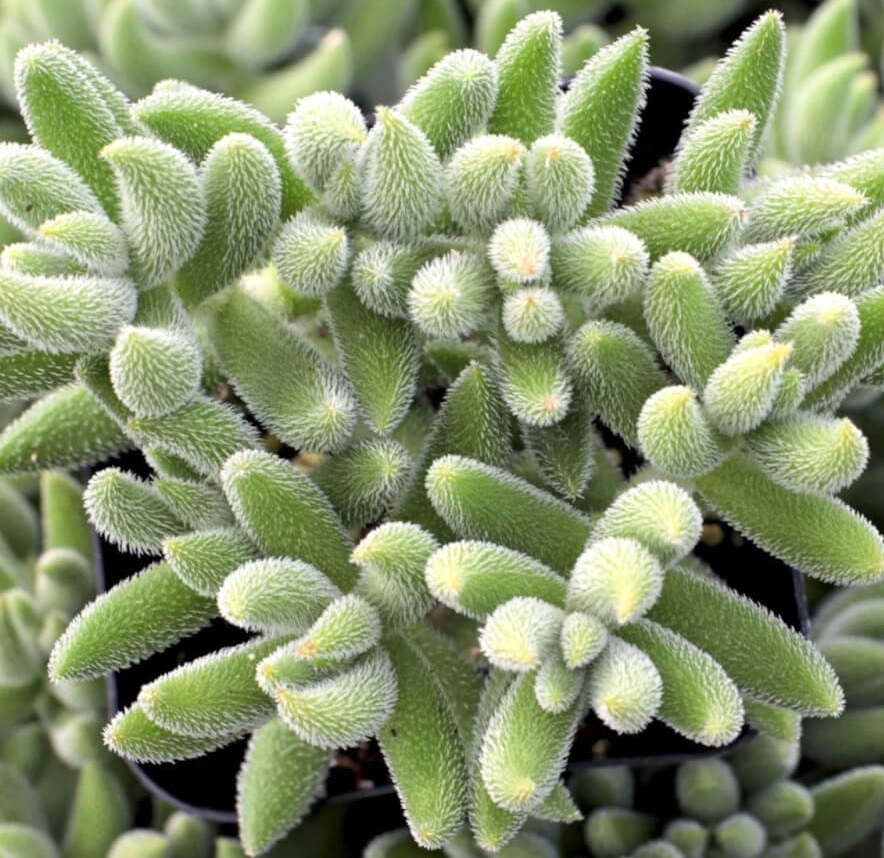
The last of the furry succulents on the list, Crassula mesembryanthemoides, hails from South Africa. The ft, white trichomes on the fuzzy succulent leaves give the plant a frosty appeal. Woody stems are well-branched, reaching over 12 inches tall. Propagate via individual leaves or stem cuttings.
Crassula mesembryanthemoides grows best in partial to filtered sun or bright light indoors. Bring it indoors for the winter, as it is hardy just to zone 10, (30° F, -1° C).
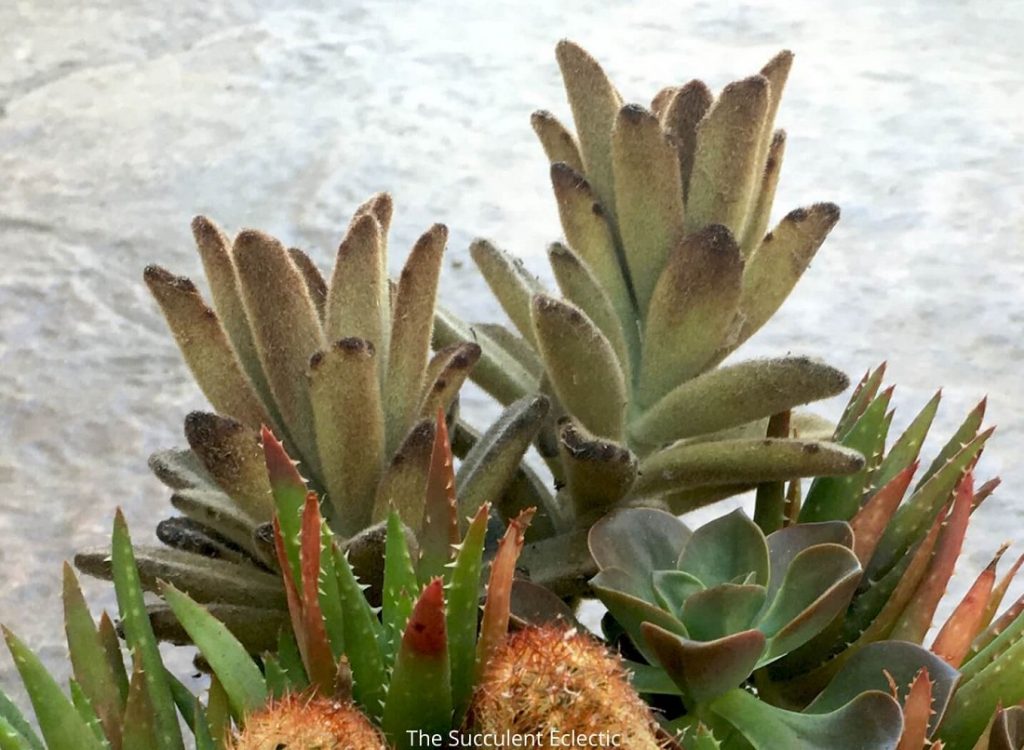
Whew! There you have it! Fuzzy succulents, the reason they evolved, how to care for them and my top 15 varieties. Would you believe that Mountain Crest Gardens has many more fuzzy succulents? What do you think? I’d love it if you would take a moment to leave a comment and let me know! Did your favorites make the list? Did you “meet” someone new you’d like to know better? Let me know and I’ll get right back to you!
Because life is just better with succulents!

P.S. For more in-depth succulent care information, please subscribe! You will also receive my FREE e-course, 7 Steps to Succulent Success! I hope you will enjoy it!
P.P.S. Why not join my Facebook Group for succulent lovers? We talk about succulent care, propagation, succulent identification, and design. It’s a warm and welcoming group that would love to meet you!
